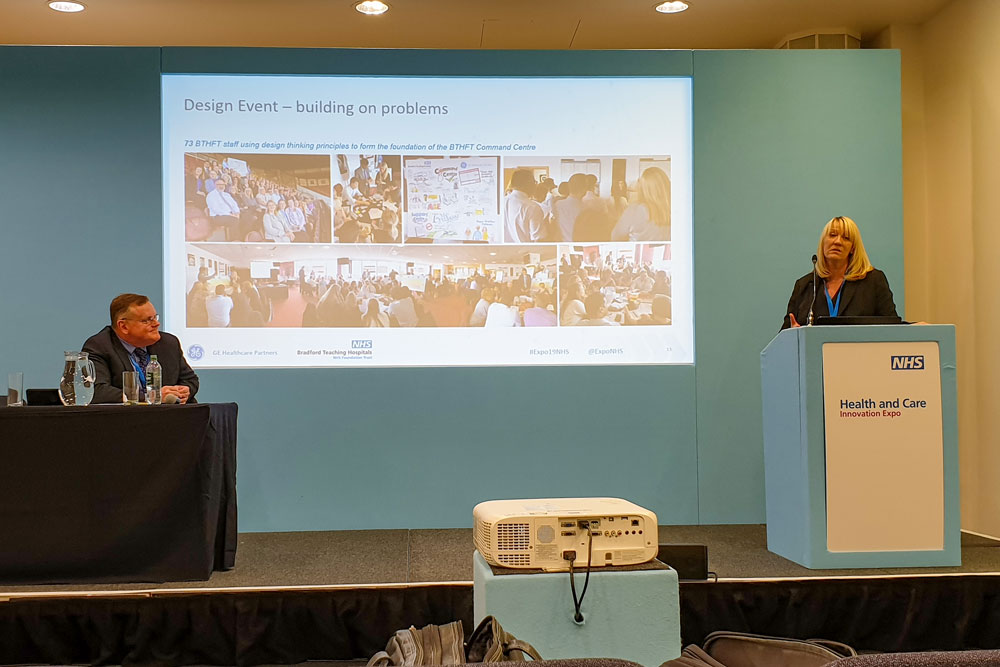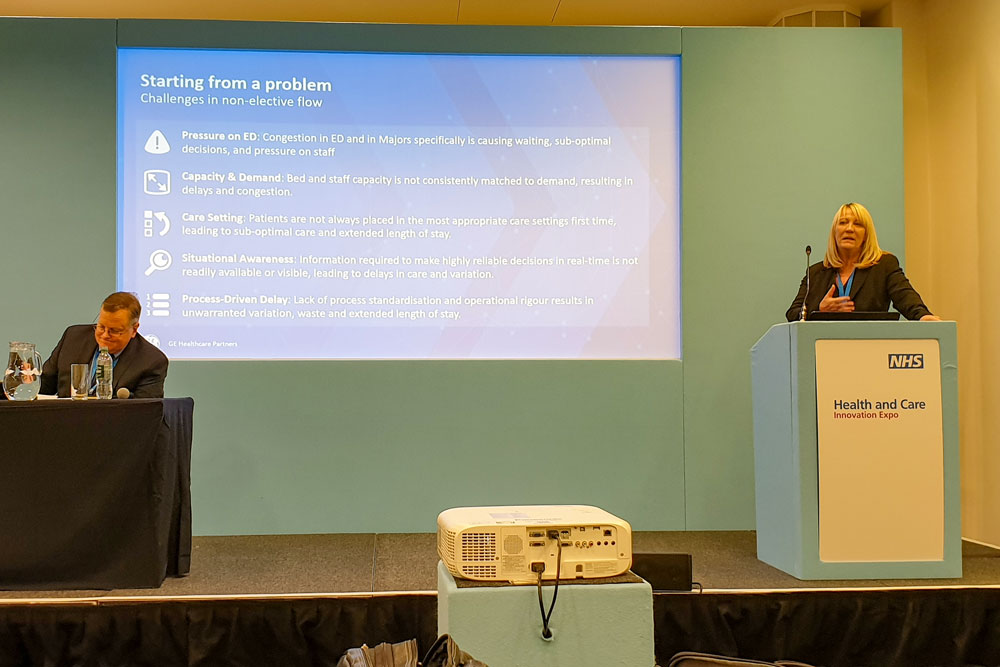Bradford Teaching Hospital NHS Foundation Trust’s space age command centre, which delivers action-oriented data to hospital and patient management teams, was officially opened this week. The work won the admiration of Highland Marketing’s advisory board when it was entered for the #HealthTechToShoutAbout category of the Health Tech Awards 2019.
Lyn Whitfield saw it demonstrated at this year’s Health and Care Innovation Expo and spoke to chief digital and information officer Cindy Fedell, about its work, which draws digitally native, real-time data from the trust’s Cerner electronic patient record and other information systems.
“Bradford is a great organisation,” Sandra Shannon, the chief operating officer of Bradford Teaching Hospital NHS Foundation Trust, told the Health and Care Innovation Expo in Manchester this summer. “It is probably the best place I have worked; but it is under pressure.”
The trust, she explained, serves a population of about half a million people, many of them young, but an increasing proportion of them elderly, and living in an area with significant pockets of deprivation. It runs six hospitals, only one of which, the Bradford Royal Infirmary, has an A&E.
The emergency department was designed for around 280 attendances per day but seeing something like 400; putting significant stress on the people working there. Without the physical space or staff to expand the unit, the trust had to find another way to reduce the pressure and improve flow through the hospital.
So, it started talking to GE about a command centre-led re-engineering and transformation programme. “This was not an IT programme, although it had a huge IT element,” Shannon said. “It was a transformation programme that started by understanding the problem and what we needed to do to resolve it.”
Data, processes, people
Cindy Fedell, Bradford Teaching Hospital’s chief digital and information officer, says that while the programme was not an IT programme, IT was critically important.
The trust implemented the Cerner Millennium electronic patient record in 2017, and needed the “native, real-time” data that it generated to feed what GE calls ‘tiles’ – data displays that relate to areas of a hospital or to individual patients, backed up by decision support that ‘triggers’ action from users.
“We talk about the tiles as being action oriented,” Fedell says. “They don’t just show something like bed status, they show that something needs to happen on this ward or to this patient. It is a system way of operating that makes things happen by making it clear what needs to happen.
“Traditional dashboards give you data, but somebody has to go and work out what to do with it. This predefines that action for you.”
First, though, GE set up a ‘digital twin’ of the hospital using four-years’ worth of historic data. This enables the trust to examine existing workflows and processes and to model the impact of changing them. Last year, before the command centre was set up, it used the digital twin to support its winter planning.
As a result, it reorganised some of its beds, created a ‘front door navigation’ model to get patients to the right place, faster, and changed the staff profile in some of its specialties. “It worked very well,” Shannon told Expo. “Staff commented that while winter was challenging, it was the best winter they had been through.”
Fedell says the same. “As somebody who does on-call, I can say that there were no frantic calls at 7pm to say: ‘We have to open overflow beds right now’,” she says. “We did open beds, but that was always planned. It was all much more controlled than in previous years, and there was less stress and so less risk.”

Air traffic control for the hospital
With data at hand, the trust set out to improve the entire patient journey “from the patient arriving at the front door to them going home again. “This was important, because improvement programmes often solve one problem, only to move it downstream,” Shannon told Expo.
It used Lean principles to re-engineer processes and pathways and thought of transformation as a way of engaging front-line staff. The starting point was a design event that brought together 73 staff to go through problems to solve. “It was a great event and very productive,” Shannon said.
“We created six out of eight tiles and identified 15 roles that would be needed in the command centre to use them effectively.”
Further design events focused on the data, analytics, and detailed design of individual tiles. “This was important, because this was something that we wanted to be done by staff, for the organisation, not to staff, by the organisation,” Shannon added.
Meanwhile, the command centre itself was identified and built. It is a large room, with a bank of screens – or ‘wall of analytics’ as GE calls it – showing the tiles at one end. The teams working in the centre have their own workstations and access to a conference room for site meetings.
The whole area is carefully lit, with lighting that changes according to the time of year and time of day. “It does look very cool. It is quite Minority Report,” Fedell laughs. “It is also very calm and very quiet and unlike many other administrative areas in the hospital.”
Working together
Teams working out of the new unit include the trust’s clinical site team – its bed managers – the bed bureau that finds beds for GPs that want to admit, virtual wards and housekeeping. Just getting them in the same space has delivered benefits.
“There is more understanding of and respect for each other’s roles,” Shannon said. For example, if the bed managers spot a patient that might be admitted to the trust’s virtual diagnostics ward, which gets patients home while they wait for tests and results, they can liaise with its managers immediately.
Meetings are also more action focused. “Before we had the command centre, the bed managers would make calls, and then probably walk the wards because they did not believe what they were told on the calls,” Shannon said. “Now, everybody has data they can believe in, so the meetings can be less about the data and more about acting on it.”

Tiles live and planned
The trust has taken a phased approach to rolling out its tiles. The first two live are ‘capacity tracker’ and ‘ED tracker’ – which respectively show pressure on the hospital and A&E.
Andy Day, managing principal, Hospital of the Future, at GE Healthcare, told Expo that further tiles will include ‘care progression’ – which is designed to pick-up issues, such as raised blood pressure in a patient, before they cause problems, like a missed theatre slot – and ‘ward link’ – for ward-specific information.
But the tile that is exciting clinicians is one that Bradford Teaching Hospitals is working on with another GE command centre user, Humber River Regional Hospital in Canada, which has adopted the NEWS2 early warning system from the UK.
Day said Bradford Teaching Hospitals already has “high compliance” with NEWS2 observations “which is great” but the tile triggers action: if a patient should have additional observations and one is missed, for example, then the tile will make sure that “somebody can go help.”
“A senior medic at Bradford told me the problem is not knowing that somebody is at risk of deterioration, but getting that information to a senior,” he said. “A nurse does the observations, they are reviewed by a junior doctor, and if there is an issue, they need to get a senior involved. The tile gets that the information to the senior faster.”
People care about data; when it cares about them
The command centre concept is relatively new. At Expo, Day talked about work that GE has done to develop the idea with Johns Hopkins University in the US, and Humber River in Toronto. Bradford Teaching Hospitals is the first organisation to adopt the idea in the UK and, indeed, in Europe.
At the end of her presentation, Shannon said the trust had taken a “risk” in taking on the project, but the results have been “wholly positive so far.”
“This is part of our vision of becoming a properly paperless organisation,” she said. “We had an EPR and the next step was a command centre. We had to be able to sell the business case to the board, because we don’t have money to burn and have to use NHS money wisely ; but we felt this would be the best use of the scarce capital that we have.
“We have really focused on flow and patient safety and the staff reaction has been very, very positive. Before go-live, we had a mock-up of the command centre in our entrance area, so people could see the tiles, and even then the reaction was very positive.”
Fedell agrees with this. In fact, she finds it interesting just how engaged the staff have been. “After the EPR project, people did say: ‘do we want to spend more money and run another big project,’ but now everybody is asking for this information,” she says.
“Which is interesting, because there is an idea that people are not interested in data; but if you give them something to do with it, they are very interested indeed.”



